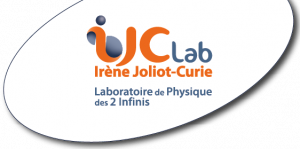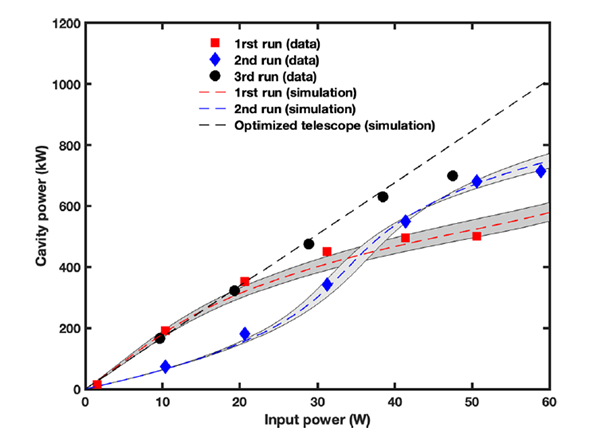
IJCLab researchers have achieved a breakthrough in high-power laser technology. The team has set a new world record by reaching a stable power of 710 kilowatts in an optical cavity - equivalent to a small power plant. This technological feat paves the way for revolutionary fundamental physics and medical imaging applications. Pictured here: hemispherical four-mirror Fabry-Pérot cavity in bow-tie configuration from the ILE team, using infrared lasers (shown in red) © IJCLab - Daniele Nutarelli
For over twenty years, the ILE (Laser Electron Interaction) team has been developing unique expertise in high-average-power Fabry-Pérot optical cavities. These cavities, formed by sophisticated mirrors, can "trap" and significantly amplify laser beam power—transforming an initial laser of a few watts into a beam of several hundred thousand watts through multiple reflections between mirrors.
These devices are coupled with particle accelerators to perform Compton backscattering experiments: a collision between accelerated electrons and laser photons that produces high-energy X-rays or gamma rays.
This technique is essential for major international projects such as the FCC-ee (future circular electron collider at CERN) and the ILC (International Linear Collider), particularly for polarimetry - the precise measurement of beam polarization.
In 2013, participation in the Mighty Laser project in Japan marked a first victory with the production of polarized gamma rays through inverse Compton scattering. A decade of improvements in the Laser-Cavity system’s power and stability followed, notably through close collaboration with the Advanced Materials Laboratory (LMA) in Lyon to develop very high-quality multilayer mirrors.
ThomX- The optical cavity at the interraction point with the electrons of the storage ring (between red dipoles), where the X-Rays are produced © IJCLab - Daniele Nutarelli
These efforts led to two major successes: the production of X-rays on the ThomX accelerator in June 2023, followed by the establishment of a world record in July 2024 with a stable laser power of 710 kilowatts stored in an optical cavity - a remarkable amplification performance comparable to the power of a small power plant.
Learn more:
The ILE team has achieved a major milestone in optimizing high-power optical cavities by obtaining a record stable average power of 710 kW in a four-mirror hemispherical Fabry-Pérot cavity in bow-tie configuration. This cavity features an exceptional finesse of 45,000 - a parameter that quantifies its ability to store light.
Average power stored in the OEC compared to the input average power - Fig. 2 "710 kW stable average power in a 45,000 finesse two-mirror optical cavity". Lett. 49, 6884-6887 (2024)
This configuration uses a Suprasil 3001 plane input mirror (transmission 113 ± 1 ppm) and a ULE output mirror with a radius of curvature of 2.241 m (transmission 1.75 ± 0.01 ppm). The optimization of the cavity geometry, particularly accounting for thermal effects (thermal lensing and surface deformation), has achieved an effective enhancement factor of 18,400, setting a new standard for high-average-power laser systems.
This performance results from significant advances in several areas:
- Mastery of thermal effects in mirror coatings (absorption <0.6 ppm)
- Optimization of mode-matching coupling (precise adaptation between incident laser beam and cavity)
- Active stabilization via the Pound-Drever-Hall technique
- Development of high-performance multilayer mirrors (LMA-Lyon collaboration)
These results pave the way toward the megawatt regime, crucial for projects like GammaFactory (CERN) and SSMB (steady-state microbunching) with exceptional amplification: 200 kW obtained with only 11 W of incident laser power, enabling significant cost reductions for Compton scattering-based radiation sources.
This major advancement results from an international collaboration bringing together experts from several institutions. IJCLab particularly acknowledges the outstanding work of the ILE team and all researchers and engineers who contributed to establishing this world record:
- IJCLab: Ronic Chiche, Kevin Dupraz, Aurélien Martens, Daniele Nutarelli, Viktor Soskov, and Fabian Zomer
- CELIA - CNRS (Center for Intense Lasers and Applications): Jérôme Lhermite
- LMA (Advanced Materials Laboratory - IP2I): Christophe Michel and Laurent Pinard
- Tsinghua University: Xin-Yi Lu, Xing Liu, Li-Xin Yan, Wen-Hui Huang, and Chuan-Xiang Tang
This success highlights the excellence of research conducted at IJCLab, supported by CNRS Nuclear and Particle Physics (IN2P3), and Paris-Saclay University. It illustrates as well the strength of international collaborations in advancing fundamental research.

























